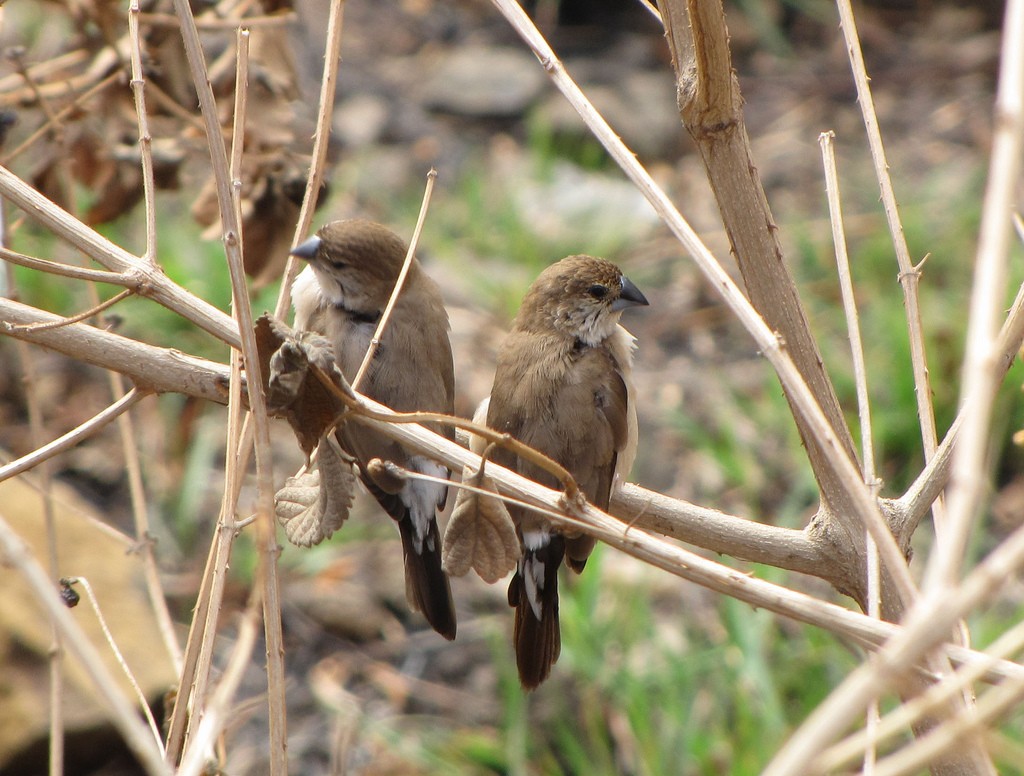Indian Silverbill
A species of Silverbill Scientific name : Euodice malabarica Genus : Silverbill
Indian Silverbill, A species of Silverbill
Botanical name: Euodice malabarica
Genus: Silverbill
Content
Description People often ask General Info
 Photo By Flickr user Pakshya , used under CC-BY-SA-2.0 /Cropped and compressed from original
Photo By Flickr user Pakshya , used under CC-BY-SA-2.0 /Cropped and compressed from original Description
The adult Indian silverbill is 11–11.5 cm long and has a conical silver-grey bill, buff-brown upperparts, white underparts, buffy flanks and dark wings. The tail is black and the wings are dark contrasting with a white rump. The sexes are similar, but immatures have buff underparts and a shorter tail. The tail appears pointed as the length of the feathers reduces from the centre outwards. It feeds mainly on seeds, but also takes insects and has been known to visit nectar bearing flowers, such as those of Erythrina trees. This munia was described as Loxia malabarica by Linnaeus who placed it along with the crossbills. Subsequently, they were included in the genera Uroloncha and Aidemosyne and later in the genus Lonchura into which many of the estrildid finches were included by Jean Delacour in his 1943 revision. The species earlier included Lonchura cantans, the African silverbill, which is found in the dry savannah habitats south of the Sahara Desert. In captivity the African birds were found to preferentially pair with mates within their own populations and did not recognize the Indian populations as conspecific. They are however known to produce fertile hybrids. 
Size
11 cm
Nest Placement
Tree
Feeding Habits
Indian Silverbill primarily feasts on a variety of seeds, including grass, sedges, rice, and millet, as well as small insects and nectar from Erythrina flowers. They forage in flocks, adept at extracting seeds with their conical beaks, demonstrating unique dietary preferences and feeding behaviors tied to their habitat.
Habitat
The indian Silverbill typically inhabits open country and semi-arid landscapes, including scrublands, open dry woodlands, and cultivated regions. This species is adaptable and can also be found in urban settings such as towns and villages. The indian Silverbill is largely a lowland bird but can be found in hilly terrains, ranging up to elevations of 600 meters, and occasionally up to 1200 meters in some regions during summer.
Dite type
Granivorous
People often ask
General Info
Feeding Habits
Bird food type
Behavior
These birds are gregarious and are found in flocks of as many as 60 birds. They feed on the ground or on low shrubs and grass stalks. They constantly utter a low cheeping or chirping contact call as they forage. They visit water and drink with a rapid sip and swallow action. Their feed on a wide range of grass seeds and will also make use of crop species. The breeding season is spread out and varies with region. They nest in winter in southern India and after summer in northern India. They nest, an untidy ball of grasses with an opening on the side, is placed in low shrubs, often on thorny Acacia and are known to make use of the old nests of baya weaver sometimes even visiting those that are occupied by the weaver birds. They will sometimes build their nest below the platform nests of vultures or storks. Old nests are used as dormitories through the year for roosting. Females are known to lay their eggs in the nests of other pairs. The clutch varies from 4 to 8 white eggs and these are incubated by both parents for about 11 days. Helpers may be involved in breeding as more than a pair are sometimes seen at a nest. Several parasitic protozoans and coccidia (Sivatoshella lonchurae) have been described from the species. 
Distribution Area
It frequents dry open scrub, fallow land and cultivation, sometimes near water. Although mainly found on the plains, they can be found up to about 1200 m in some sub-Himalayan regions. It occurs in Pakistan, Nepal, Bangladesh, India, Sri Lanka, Iran and Israel. It has been accidentally introduced into many other parts of the world and has established itself in Jordan, Israel, Kuwait, Oman, Puerto Rico, Qatar, Saudi Arabia, United States, Virgin Islands (possibly extinct) and Nice (southern France). Although largely sedentary, some populations make seasonal movements. 
Species Status
Not globally threatened.
Scientific Classification
Phylum
Chordates Class
Birds Order
Perching birds Family
Estrildid finches Genus
Silverbill Species
Indian Silverbill